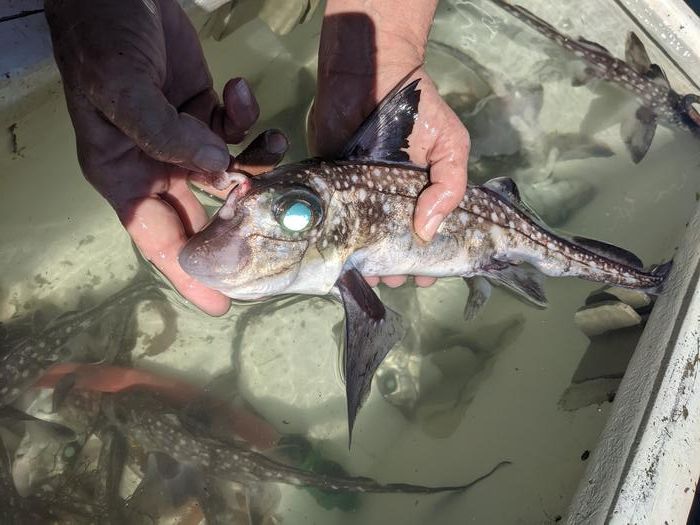Researchers suggest the rows of pointed structures on the heads of spotted ratfish are true teeth, offering the first known example of teeth located outside the jaw
/https://tf-cmsv2-smithsonianmag-media.s3.amazonaws.com/accounts/headshot/Sara_-_Headshot_thumbnail.png)
Sara Hashemi - Daily Correspondent
September 10, 2025
:focal(350x263:351x264)/https://tf-cmsv2-smithsonianmag-media.s3.amazonaws.com/filer_public/1f/28/1f288b6f-b03c-4bce-80be-64ccc1ffaefa/low-res_pxl_20220728_032905252.jpg)
Deep in the ocean, you can find a strange fish with teeth not just in its mouth, but also on its head.
The spotted ratfish, a relative of sharks, measures about two feet long and is found in the northeastern Pacific Ocean. The species belongs to a group of cartilaginous fish called chimaeras (also known as ghost sharks), and its males have a distinct feature called a tenaculum. This appendage juts out from the ratfish’s forehead and is used to grasp females during mating. What’s more, the tenaculum seems to be covered in sharp, retractable teeth.
A team of researchers set out to determine whether these pointy protrusions are true teeth, related to those in the animal’s mouth, or merely tooth-like structures known as denticles, seen in some sharks and rays.
Did you know? When did the first teeth appear?
Studies suggest the earliest teeth and jaws evolved around 450 million years ago.
To find out, the scientists examined ratfish specimens using micro-CT scans and tissue samples, then compared them with hundreds of other fish. They found that the structures were rows of actual teeth, rooted in tissue called the dental lamina, which helps give rise to new teeth. This discovery marks the first time the dental lamina has been documented outside the jaw.
“This insane, absolutely spectacular feature flips the long-standing assumption in evolutionary biology that teeth are strictly oral structures,” says Karly Cohen, a researcher at the University of Washington, in a statement. “The tenaculum is a developmental relic, not a bizarre one-off, and the first clear example of a toothed structure outside the jaw.”
The researchers also identified genes in the tenaculum found only in true teeth, further supporting the results. The findings were published in the journal Proceedings of the National Academy of Sciences on September 4.
 A male spotted ratfish and its tenaculum, seen extended from the front of its head
Gareth J. Fraser, University of Florida
A male spotted ratfish and its tenaculum, seen extended from the front of its head
Gareth J. Fraser, University of Florida
“I think it’s utterly amazing that ghost sharks have teeth growing out of their forehead,” says Dominique Didier, an ichthyologist at Millersville University who was not involved in the research, to Jack Tamisiea at the New York Times.
The tenaculum teeth are used for grabbing onto a female during sex. Spotted ratfish also have pelvic claspers for this purpose, which display tooth-like structures, too. But the pelvic claspers didn’t show genetic evidence of true teeth, suggesting these are merely denticles.
On the tenaculum, the hooked teeth form seven or eight rows. “The rows of teeth are all organized in a very similar way in this conveyor belt of teeth that we see in sharks,” says study co-author Gareth Fraser, an evolutionary biologist at the University of Florida, to the New York Times.
A spotted ratfish common to the Puget Sound

The researchers looked through the fossil record at closely related species that also have a tenaculum and found evidence of teeth in those animals, too. Helodus simplex, a cartilaginous fish dating back roughly 315 million years, has the oldest known example of a tenaculum. The tenaculum of H. simplex was closer to the jaw, compared to that of today’s ratfish. Over the years, this tenaculum could have evolved into the teeth the ratfish currently have on their heads, per the paper.
/https://tf-cmsv2-smithsonianmag-media.s3.amazonaws.com/filer_public/e2/5f/e25f37ee-06da-4ef4-a0f9-f431fc24fa5e/figure6-panelf-1536x1082.jpg) An illustration of H. simplex and its tenaculum
Ray Troll
An illustration of H. simplex and its tenaculum
Ray Troll
Didier tells the New York Times that the tenaculum could have evolved for a purpose beyond mating, because the females of one ratfish lineage have remnants of the structure, which suggests it was once found across both sexes.
“There are still plenty of surprises down in the ocean depths that we have yet to uncover,” Fraser adds in another statement.
Get the latest stories in your inbox every weekday.
- More about:
- Animals
- Biology
- Evolution
- Fish
- New Research
- Oceans
- Pacific Ocean
- Teeth
- Wildlife
.png)


